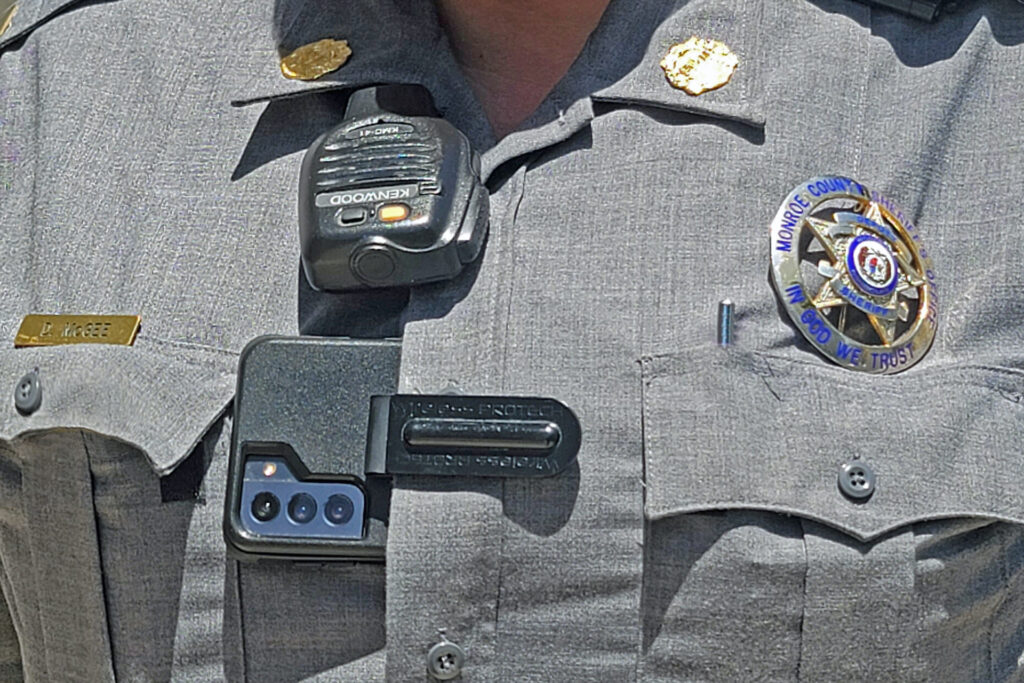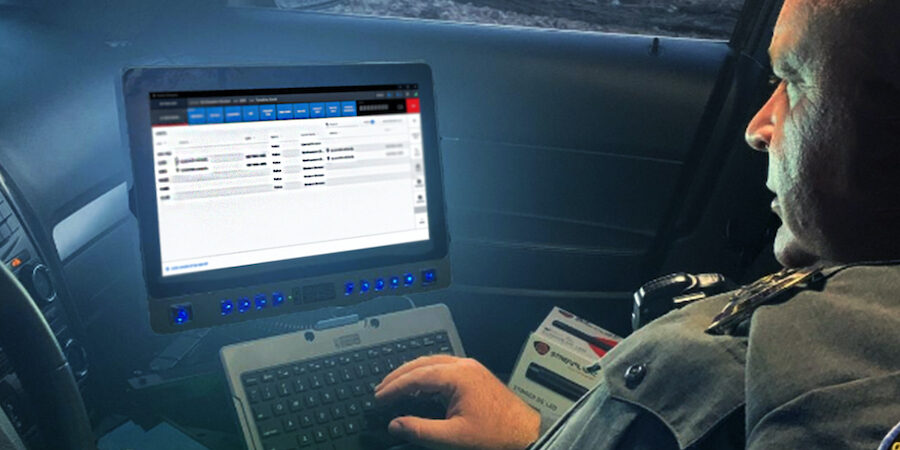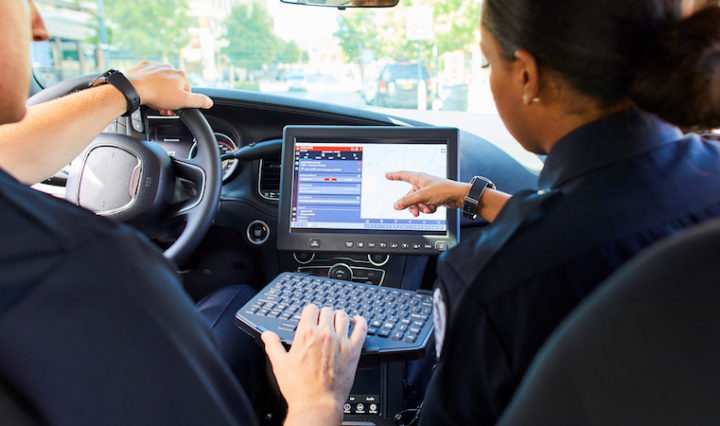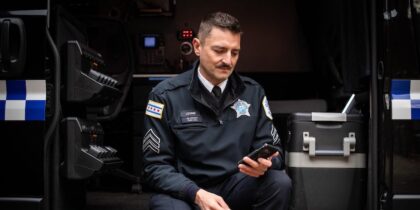When Sheriff Joe Colston took over the top job at the Monroe County Sheriff’s Office (MCSO) in Missouri, one of the first things he did was embrace smartphones as a force multiplier for his small agency. The department has nine deputies, and they’re tasked with protecting nearly 9,000 residents spread across almost 650 square miles. Colston knew that equipping each deputy with a smartphone would improve both efficiency and communications.
Colston, who had been using a department-issued Samsung Galaxy smartphone in his previous position as chief deputy, also wanted to leverage Samsung DeX, which pairs a smartphone with a dedicated display and keyboard to provide the functional equivalent of an in-car computer. Colston had heard about DeX and had seen a related case study on the Chicago Police Department. He decided to try DeX before committing to a full deployment effort.
“I checked it out on my own to make sure it would work with the apps and programs that we utilize daily,” he says. “[Using DeX] seemed like the next logical step after I knew it was functional.”
Phones as desktop computers and more tech advancements
As smartphones were being rolled out to the deputies, MCSO set up three DeX workstations in the area where reports were often completed. “Each has a keyboard, mouse and monitor, and it’s set up in their office,” Colston says. “They had been using outdated laptops that often did not work very well. Now they utilize their phone and DeX to do their reports and any other kind of computing they might need to do. We do have one Windows PC that is hooked up to a scanner and some other equipment that is Windows-specific but most of what they do now is on DeX.”
In the MCSO deputies’ take-home vehicles, they installed a DeX setup consisting of a Gamber-Johnson touchscreen and keyboard with a touchpad. A RAM mount that attaches to the bolts on the passenger seat is used to position the DeX-enabled monitor and keyboard, so they’re accessible to the deputy like a conventional in-car computing setup. Colston handled the equipment installation with assistance from his chief deputy. “We’re a small agency so any way that we can save money is important; we do a lot of this [work] ourselves,” Colston says.
Grant funding covered most of the expenses associated with the DeX equipment. “We do a lot of grants,” Colston explains. “The local law enforcement block grant is what we used for the vehicle setups. We always watch our dollars and make them go as far as possible.”
Colston noted that several years prior, MCSO had used a grant to obtain mobile data computers, but due to the cost of the equipment, the agency was only able to purchase two rugged laptops. This meant just two of MCSO’s nine deputies had computers, significantly impacting the effective sharing of information.
MCSO’s 911 dispatch center recently began using Central Square computer-aided dispatch (CAD), and this has meshed well with MCSO’s smartphone efforts. “[Central Square] has an app called Field Ops that allows us to see the calls in real time, and we can do that from our DeX system,” Colston says. “There’s also mapping integrated with call location data so that we can get turn-by-turn directions to the incident.”
The records management system (RMS) that MCSO uses is from Caliber Public Safety, and, since it’s web-based, it also works well with DeX. The net result is that MCSO deputies can now rely on a single device — their smartphone — for full access to the mission-critical information they need from both their CAD and RMS systems. And this access is readily available to them in the car, in the field and in the station.
“From my personal experience doing investigations, it’s been really nice to be able to log into the system and see pieces of the puzzle that are relevant to what we’re doing,” says Colston. “We’re collecting more data, and the more information that you have while you’re in the field, the better off and more effective you are.”
Currently, deputies usually complete their reports in the station, but Colston believes that will be changing as a result of the technology that’s now available in the patrol cars. “Right now, they’re coming back to the office but with this [DeX] solution in the car, we’re hopeful they’ll be doing most of their reports in the car, especially low-level reports without a lot of evidence processing,” Colston says. “There’s so much paperwork, the more they come into the office, the less they’re out in the field. We want them to be seen, and this will absolutely increase their engagement with the community.”
Body cameras
Colston felt it was important to address the agency’s outdated body cameras and decided to leverage the deployment of smartphones by working with Visual Labs, a software provider whose solution enables officers to use smartphones as body cameras.
“A benefit of the Visual Labs setup is the videos are being uploaded from the field,” Colston says. “Before, deputies would do five or six calls, and then go back to the office to upload the videos and categorize the calls. It was hard to remember everything. It’s also a much more streamlined process for evidence. We used to have to burn three copies after downloading the videos at the offices: one copy for evidence, and a copy for both the prosecution and the defense. Now, we’re emailing links to the videos. It’s eliminated a lot of processing time, and it’s much easier to find a specific video. And the video evidence has led to fewer trials. That saves a lot of money.”
 The smartphone/body cam solution is also being used as an in-car camera when needed. “Most of our vehicles have a cradle that we put on the dash so we can capture driving offenses [with the smartphone] if we need it,” Colston explains.
The smartphone/body cam solution is also being used as an in-car camera when needed. “Most of our vehicles have a cradle that we put on the dash so we can capture driving offenses [with the smartphone] if we need it,” Colston explains.
Since videos are being uploaded from the field, the sheriff can review a video without a deputy having to return to the station. “That’s a benefit of this setup,” he says. “When I get a call, I can watch the incident from my desk by looking it up.”
Colston noted the Visual Labs software has improved situational awareness by making more information readily available. “We had a situation where we were looking at a specific area and needing additional info,” he says. “We were able to easily do a search by doing a geo-circle of the location and specifying a timeframe. We could see all the contacts in that area, and there was relevant activity that we didn’t realize had happened.”
How much can going mobile-first save your agency?
Use our calculator to see how much your agency could save by leveraging Samsung DeX. Download Now
Carrier support
MCSO is using UScellular, and the carrier played a key role in the smartphone deployment, according to Colston. “When I took over as sheriff in January of last year, they were very helpful,” he says. “I had two main goals. One was to use DeX and the other to use Visual Labs. [UScellular] got us set up with the right phones, and they were able to identify a plan that would meet our needs.”
Key to success: Leveraging mobile
It was important to Colston that every budget dollar be maximized while effectively leveraging smartphone technology as a force multiplier. “We are very proud of this project and what we’ve been able to do,” he says. “We’re using one [smartphone] device for so many things. Budgets are tight for everyone, and a traditional setup [for in-car computing] is $5,000 or $6,000, and then you have to find a solution for connectivity.”
“Our setup is a little less than $1,000 per car,” he says. “The smartphones are something that we were going to have anyway,” Colston says. “And now we have GPS capability at a deputy level. The smartphone has replaced four or five pieces of equipment, and we’re not settling for something less. It’s great equipment and has allowed us to use our dollars more effectively. We weren’t able to support every deputy before. Now we can. We’ve been very happy with our investment as it has allowed us to utilize the Samsung devices to accomplish many of our technology goals while saving a great deal of money.”
You can find out more about planning and implementing a cost-saving mobile initiative at your agency with this practical roadmap. And you can view Samsung’s lineup of force-multiplying mobile devices for public safety.









